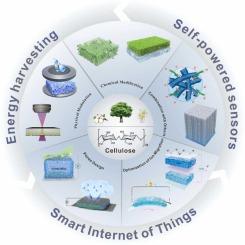湿发电机用纤维素功能材料:优势、策略与展望
IF 17.1
1区 材料科学
Q1 CHEMISTRY, PHYSICAL
引用次数: 0
摘要
纤维素基材料由于其可再生特性、可生物降解性和多用途的结构适应性,已成为湿电发电机(meg)的有希望的候选者。本文综述了MEGs功能纤维素材料的分子特性、改性策略和性能优化等方面的研究进展。纤维素具有丰富的羟基和层次结构,有利于离子梯度扩散和湿电转换的流势机制。系统地讨论了化学功能化(如羧基化、磺化)、物理调制(如激光诱导石墨化、共混)和孔结构工程等关键策略,以提高表面电荷密度、离子传输效率和环境适应性。值得注意的是,优化后的基于纤维素的meg可实现超过1v的电压和高达10⁶nW cm-²的功率密度,可用于直流电源、自供电传感器和智能物联网系统。展望了低湿度性能、环境适应性和可持续性等挑战,并强调了未来对机理研究、多功能集成和可持续能源生态系统的需求。这项工作强调了纤维素推动绿色能源技术的潜力,为推进下一代环保meg提供了见解。本文章由计算机程序翻译,如有差异,请以英文原文为准。

Cellulose functional materials for moisture-electric generators: Advantages, strategies, and perspectives
Cellulose-based materials have emerged as promising candidates for moisture-electric generators (MEGs) due to their renewable nature, biodegradability, and versatile structural adaptability. This review comprehensively summarizes recent advancements in functional cellulose materials for MEGs, focusing on their molecular characteristics, modification strategies, and performance optimization. Cellulose, with its abundant hydroxyl groups and hierarchical structure, facilitates ion gradient diffusion and streaming potential mechanisms for moisture-electric conversion. The critical strategies such as chemical functionalization (e.g., carboxylation, sulfonation), physical modulation (e.g., laser-induced graphitization, blending), and pore structure engineering are systematically discussed to enhance surface charge density, ion transport efficiency, and environmental adaptability. Notably, optimized cellulose-based MEGs achieve voltages exceeding 1 V and power density up to 10⁶ nW cm-², enabling applications in direct-current sources, self-powered sensors, and smart IoT systems. Challenges such as low-humidity performance, environmental adaptability, and sustainability are prospected, with future perspectives highlighting the need for mechanistic studies, multifunctional integration, and sustainable energy ecosystems. This work underscores cellulose’s potential to drive green energy technologies, offering insights for advancing next-generation, eco-friendly MEGs.
求助全文
通过发布文献求助,成功后即可免费获取论文全文。
去求助
来源期刊

Nano Energy
CHEMISTRY, PHYSICAL-NANOSCIENCE & NANOTECHNOLOGY
CiteScore
30.30
自引率
7.40%
发文量
1207
审稿时长
23 days
期刊介绍:
Nano Energy is a multidisciplinary, rapid-publication forum of original peer-reviewed contributions on the science and engineering of nanomaterials and nanodevices used in all forms of energy harvesting, conversion, storage, utilization and policy. Through its mixture of articles, reviews, communications, research news, and information on key developments, Nano Energy provides a comprehensive coverage of this exciting and dynamic field which joins nanoscience and nanotechnology with energy science. The journal is relevant to all those who are interested in nanomaterials solutions to the energy problem.
Nano Energy publishes original experimental and theoretical research on all aspects of energy-related research which utilizes nanomaterials and nanotechnology. Manuscripts of four types are considered: review articles which inform readers of the latest research and advances in energy science; rapid communications which feature exciting research breakthroughs in the field; full-length articles which report comprehensive research developments; and news and opinions which comment on topical issues or express views on the developments in related fields.
 求助内容:
求助内容: 应助结果提醒方式:
应助结果提醒方式:


